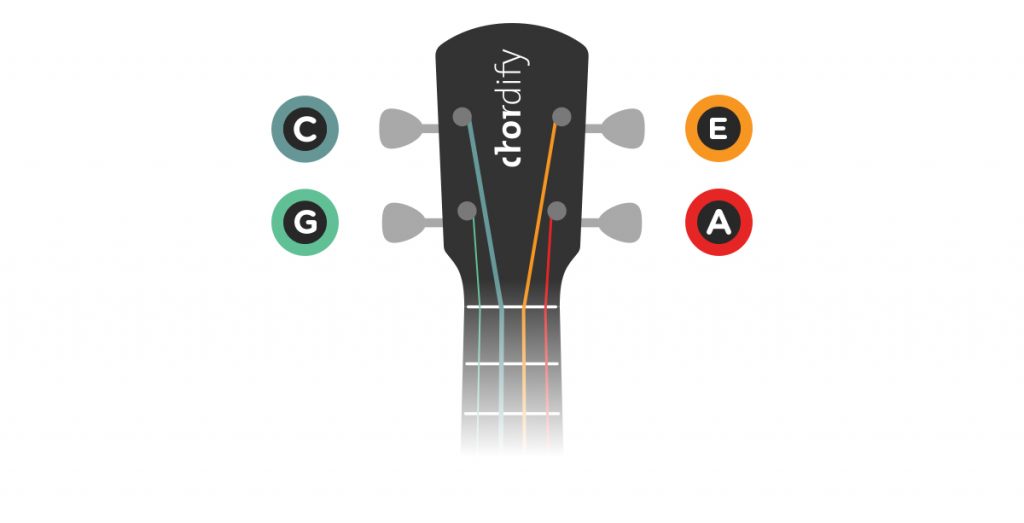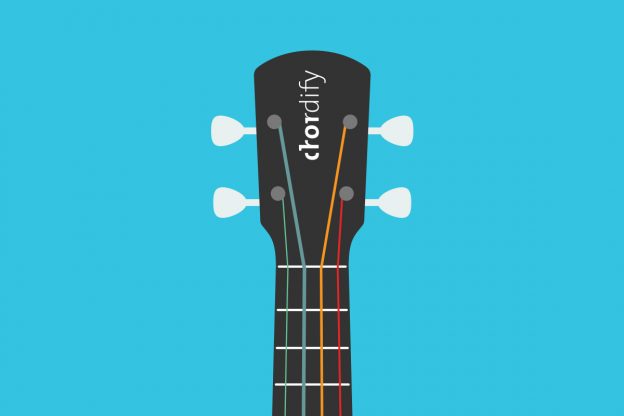The ukulele is one of the coolest instruments. It’s small, has an open tuning, and only four strings, which makes it the ideal traveling companion. The big question is: How do I tune my ukulele? In this blog post we’ll show you three ways of how to do that.
Estimated reading time: 7 minutes
In this blogpost on how to tune your ukulele you’ll find
Types of Ukulele
There’s a couple of different types of ukulele, but you’ll most likely end up jamming on a Soprano, Concert or Tenor. Luckily, they all usually have the same tuning: A4, E4, C4, G4. But before we dive deeper into the notes of the strings, let’s briefly talk about the four basic types of ukuleles. Going from the smallest to the biggest in size, we have:
- Soprano
- Concert
- Tenor
- Baritone
The main difference between them is the size of the ukulele body and consequently the size of the frets: Smaller ukuleles have smaller frets and vice versa. The number of frets on the ukulele fretboard increases from Soprano (12 to 15 frets depending on the instrument) to Baritone (at least 18 frets), as well as the tension of the strings.
Ukulele tuning
Here’s the good news: The Soprano, Concert and Tenor usually have the same tuning, which is: A4, E4, C4, G4. These letters indicate the notes of the open strings. This automatically makes it the most common tuning for the ukulele. The Baritone ukulele has a different tuning: D,G,B,E.

Simply put, you should see these letters on screen if you’re tuning your ukulele with an electronic tuner, or a tuning app on your phone. Then you can be sure that your ukulele is ready for jamming.
But what if you don’t have a tuner around? Or how did people tune their ukulele in the old days, when tuners did not exist? The answer is way simpler than the act itself: they tuned by ear. It takes some practice, but it can be learned. And it is a very good way of training your hearing!
Tuning Ukulele by ear
Tuning with Piano or Guitar
Now you know how your ukulele should be tuned. Imagine you don’t have a tuner, or you would like to train yourself to tune your ukulele by ear. If you have a piano or guitar lying around (and it’s in tune) – or if you jam together with a guitar or piano player – you can match the sound of each of your open strings with the four notes played on piano or guitar: A4, E4, C4, G4.
The ukulele’s first open string should be tuned to A4. By first string we mean the one closest to the floor when you’re holding the instrument in playing position. Play this open string and match it with the sound of the A4 note on piano or guitar.
Use the tuning peg to adjust the sound as closely as possible to the sound of the A4 note on the piano or guitar. The same procedure applies to the ukulele’s other strings: the second string should be tuned to the E4 note, the third string to the C4, the fourth to the G4.
Tuning with a tuning fork
First string (A4) and turning fork
Maybe you’ve heard about the tuning fork – a metal tool which can generate a certain pitch. Most commonly, it generates a pitch of 440 Hz when you hit it against something, known as the A4 note. We’ll describe the tuning process below, based on the tuning fork of that pitch.
Remember which ukulele string is tuned to the A4 note (see the picture above)? Right, it’s the first string. Let’s turn the tuning peg to match the sound of the first open string with the sound of the tuning fork. Once you have tuned the first string to the A note, you’re able to tune the rest of the strings by using your ears.
The second string (E4) and the first string (A4)
You can now use the open first string to tune the second string. But how do I know when the open second string sounds like the E4, you may ask? Let’s find the A note on the second string! After starting at the E note (open string), crossing the F and the G notes on our way up, we come across the A note, which is on the fifth fret.

So, you can play the fifth fret on the second string and match it with the sound of the first open string, which is the A4 note. If the sounds don’t match up just right, use the tuning peg of the E string to adjust its tension.
The third string (C4) and the second string (E4)
The third string can be tuned with the second open string using the same principle: First, let’s find the note on the third string which matches the sound of the second open string – the E note. And then you can play this note together with the second open string.
We’re starting from the C note (open string), crossing the D note, and eventually ending up on the E note, which is on the fourth fret.

You can play the fourth fret on the third string and match it with the sound of the second open string, which is the E4 note. If the sounds don’t really match, you can use the tuning peg of the C string to adjust its tension.
The fourth string (G4)
The tuning of the fourth open string is different from the second and third strings. This is because the fourth open string is tuned to the G4 note, which is already higher than the previous open strings. Therefore, it’s simply impossible to find C4 or E4 on the fourth string to match it with the sound of the open third or second string.
But don’t fret! The first string (A4) can be a great help here. We need to find the A4 note on the G-string, which is the next adjacent note after the G.

So, you can play the second fret on the fourth string, and try to match it with the sound of the first open string, which is the A note. If the sounds don’t really match, you can use the tuning peg of the G string to adjust its tension.
In conclusion
You’ve just learned three different ways to tune your ukulele. The easiest is with a tuner. You can use different apps on your phone for this purpose. The second way is a bit more difficult, but very good for your musical hearing. Tuning by ear with a piano or guitar can be a challenge, but you definitely need to try it out.
Last but not least, we showed you how you can use a tuning fork to tighten those strings in the pitch you like. This method can also be used when you just tune one string with the help of a piano or a guitar. So, from now on you can keep your ukulele in tune, ready for action. Yup, no excuses. Check out or ukulele channel for inspiration. Happy jamming!



